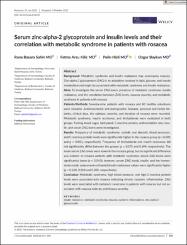Serum zinc-alpha-2 glycoprotein and insulin levels and their correlation with metabolic syndrome in patients with rosacea
| dc.contributor.author | Sahin, Rana Basara | |
| dc.contributor.author | Kılıç, Fatma Arzu | |
| dc.contributor.author | Hızlı, Pelin | |
| dc.contributor.author | Baykan, Özgür | |
| dc.date.accessioned | 2023-07-20T07:16:15Z | |
| dc.date.available | 2023-07-20T07:16:15Z | |
| dc.date.issued | 2022 | en_US |
| dc.identifier.issn | 1473-2130 / 1473-2165 | |
| dc.identifier.uri | https://doi.org/10.1111/jocd.15447 | |
| dc.identifier.uri | https://hdl.handle.net/20.500.12462/13233 | |
| dc.description | Kılıç, Fatma Arzu (Balikesir Author) | en_US |
| dc.description.abstract | Background: Metabolic syndrome and insulin resistance may accompany rosacea. Zinc-alpha-2 glycoprotein (ZAG) is an adipokine involved in lipid, glucose, and insulin metabolism and might be associated with metabolic syndrome and insulin resistance. Aims: To investigate the serum ZAG levels, presence of metabolic syndrome, insulin resistance, and the correlation between ZAG levels, rosacea severity, and metabolic syndrome in patients with rosacea. Patients/Methods: Seventy-nine patients with rosacea and 80 healthy volunteers were included. Anthropometric and demographic features, personal and family histories, clinical data, the subtype, severity, and duration of rosacea were recorded. Metabolic syndrome, insulin resistance, and dyslipidemia were evaluated in both groups. Fasting blood sugar, lipid panel, C-reactive protein, sedimentation rate, insulin, and serum ZAG levels were investigated. Results: Frequency of metabolic syndrome, systolic and diastolic blood pressures, and C-reactive protein levels were significantly higher in the rosacea group (p< 0.001 and p = 0.001, respectively). Frequency of dyslipidemia and insulin resistance did not significantly differ between the groups (p = 0.175 and 0.694, respectively). The mean serum ZAG levels were lower in the rosacea group, but no significant difference was evident. In rosacea patients with metabolic syndrome, serum ZAG levels were significantly lower (p = 0.043); however, serum ZAG levels, insulin, and the homeostasis model assessment-estimated insulin resistance values were significantly higher (p = 0.168, 0.013 and 0.001, respectively). Conclusion: Metabolic syndrome, high blood pressure, and high C-reactive protein levels were associated with rosacea indicating chronic systemic inflammation. ZAG levels were associated with metabolic syndrome in patients with rosacea but not associated with rosacea subtype and disease severity. | en_US |
| dc.description.sponsorship | Scientific Research Project Unit of Balikesir University | en_US |
| dc.language.iso | eng | en_US |
| dc.publisher | Wiley | en_US |
| dc.relation.isversionof | 10.1111/jocd.15447 | en_US |
| dc.rights | info:eu-repo/semantics/openAccess | en_US |
| dc.rights | Attribution 3.0 United States | * |
| dc.rights.uri | http://creativecommons.org/licenses/by/3.0/us/ | * |
| dc.subject | Insulin Resistance | en_US |
| dc.subject | Metabolic Syndrome | en_US |
| dc.subject | Rosacea | en_US |
| dc.subject | Systemic Inflammation | en_US |
| dc.subject | Zinc-Alpha-2 Glycoprotein | en_US |
| dc.title | Serum zinc-alpha-2 glycoprotein and insulin levels and their correlation with metabolic syndrome in patients with rosacea | en_US |
| dc.type | article | en_US |
| dc.relation.journal | Journal of Cosmetic Dermatology | en_US |
| dc.contributor.department | Tıp Fakültesi | en_US |
| dc.identifier.volume | 22 | en_US |
| dc.identifier.issue | 2 | en_US |
| dc.identifier.startpage | 645 | en_US |
| dc.identifier.endpage | 650 | en_US |
| dc.relation.publicationcategory | Makale - Uluslararası Hakemli Dergi - Kurum Öğretim Elemanı | en_US |
Bu öğenin dosyaları:
Bu öğe aşağıdaki koleksiyon(lar)da görünmektedir.
-
Dahili Tıp Bilimleri-Makale Koleksiyonu [672]
Internal Medicine-Article Collection -
Pubmed Makale Koleksiyonu [971]
Pubmed Article Collection -
Scopus İndeksli Yayınlar-Makale Koleksiyonu [4974]
Article Collection -
WOS İndexli Yayınlar-Makale Koleksiyonu [4952]
WOS Indexed Publications-Article Collection




















